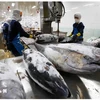Two-way trade between Vietnam and Russia hit 2.6 billion SD in 2014, which, however, accounted for less than 1 percent of Vietnam's total import-export activity with the world, which stood at 298.2 billion USD.
This means that the economic potential between the two nations was not being fully exploited, according to the General Department of Vietnam Customs.
Enterprises that trade with Russia said that it was difficult for them to expand their markets even though demand for Vietnamese products was high.
They said the main reasons were harsh import regulations and high taxes Russia imposed on some products.
Many goods exported to Russia have to go through a third country in Europe, instead of going directly from Vietnam to Russia, like wood products.
Vietnamese wood product exports to Russia remain slow despite interest from the Russian market.
Tran Quoc Manh from the HCM City Handicraft and Wood Industry Association (HAWA) said that Russia applied a tax for imported wood products based on weight, and wood products are heavy so the taxes are high.
Seafood enterprises also face difficulties. Although up to 400 Vietnamese seafood enterprises are allowed to export to the European market, only about 30 are licensed to export to Russia.
For better and more sustainable export results, experts urged Vietnamese enterprises to develop a strategy for production and exports.
Vietnamese enterprises have high expectations on opportunities to exploit the Russian market when the free trade agreement (FTA) between Vietnam and the Customs Union of Russia, Belarus and Kazakhstan is signed.
The negotiations were concluded in last December, and the two sides are preparing for the official signing of the FTA in 2015.
When the FTA is signed, Vietnamese exports to Russia, including agriculture, aquatic products, garments, textiles, footwear and wood products, will be offered preferential taxes.
Russia's import demand consists of consumer products like garments and textiles, footwear, fine arts and handicrafts, processed food, agricultural and seafood products and building materials.
The two countries target to reach a trade turnover of 10 billion USD by 2020.-VNA
This means that the economic potential between the two nations was not being fully exploited, according to the General Department of Vietnam Customs.
Enterprises that trade with Russia said that it was difficult for them to expand their markets even though demand for Vietnamese products was high.
They said the main reasons were harsh import regulations and high taxes Russia imposed on some products.
Many goods exported to Russia have to go through a third country in Europe, instead of going directly from Vietnam to Russia, like wood products.
Vietnamese wood product exports to Russia remain slow despite interest from the Russian market.
Tran Quoc Manh from the HCM City Handicraft and Wood Industry Association (HAWA) said that Russia applied a tax for imported wood products based on weight, and wood products are heavy so the taxes are high.
Seafood enterprises also face difficulties. Although up to 400 Vietnamese seafood enterprises are allowed to export to the European market, only about 30 are licensed to export to Russia.
For better and more sustainable export results, experts urged Vietnamese enterprises to develop a strategy for production and exports.
Vietnamese enterprises have high expectations on opportunities to exploit the Russian market when the free trade agreement (FTA) between Vietnam and the Customs Union of Russia, Belarus and Kazakhstan is signed.
The negotiations were concluded in last December, and the two sides are preparing for the official signing of the FTA in 2015.
When the FTA is signed, Vietnamese exports to Russia, including agriculture, aquatic products, garments, textiles, footwear and wood products, will be offered preferential taxes.
Russia's import demand consists of consumer products like garments and textiles, footwear, fine arts and handicrafts, processed food, agricultural and seafood products and building materials.
The two countries target to reach a trade turnover of 10 billion USD by 2020.-VNA



















